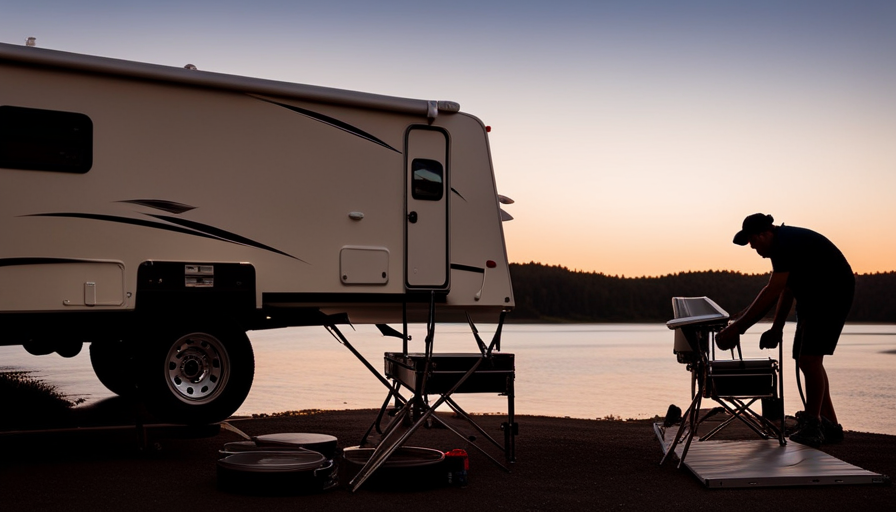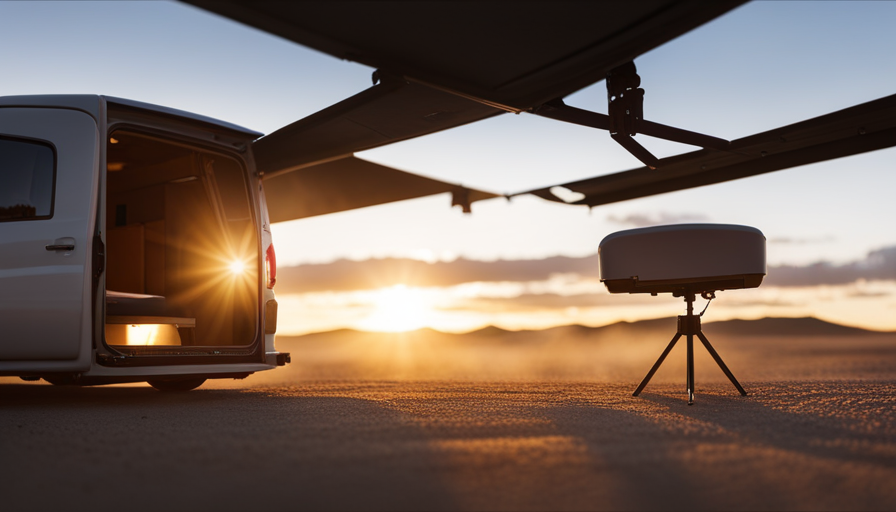Have you ever woken up in your RV only to find your windows covered in a thick layer of condensation? It can be annoying and potentially lead to mold and mildew if left untreated. But fear not, fellow campers! I have some helpful tips to keep your RV windows clear and prevent fogging.
First and foremost, let’s understand the causes of window sweating. It typically occurs when warm, moist air inside your camper comes into contact with the cold surface of the windows. To combat this, improving ventilation is key. Opening windows and using fans can help circulate the air and prevent excessive moisture buildup.
Another effective solution is using dehumidifiers or moisture absorbers. These devices work wonders in removing excess moisture from the air, keeping your camper nice and dry. Additionally, insulating your camper windows can help prevent cold surfaces that promote condensation.
Controlling moisture inside your camper is also crucial. Be mindful of activities that generate moisture, such as cooking or showering, and make sure to properly ventilate these areas.
By following these practical tips, you can bid farewell to those pesky window sweats and enjoy a comfortable and dry camping experience.
So, let’s dive into the details and keep those camper windows crystal clear!
Key Takeaways
- Improve ventilation by opening windows and using fans to prevent excessive moisture buildup.
- Use dehumidifiers or moisture absorbers to remove excess moisture from the air and keep the camper dry.
- Insulate camper windows to reduce cold surfaces and prevent condensation.
- Control moisture inside the camper, especially during activities that generate moisture like cooking or showering.
Understand the Causes of Window Sweating
Are your camper windows constantly sweating? Find out why and how to prevent it!
Window condensation is a common problem in campers and can be caused by a variety of factors. One of the main causes is high humidity inside the camper. When warm, moist air comes into contact with a cold window surface, it condenses and forms water droplets.
To reduce humidity in your camper, there are several steps you can take. First, make sure to properly ventilate your camper by opening windows or using exhaust fans. This will help to circulate the air and prevent moisture buildup.
Additionally, you can use a dehumidifier or moisture absorber to remove excess moisture from the air. Another effective way to reduce humidity is by using ventilation fans while cooking, showering, or doing any activities that generate steam.
By reducing the humidity levels in your camper, you can prevent window condensation and keep your windows clear and dry. Improving ventilation in your camper is crucial to maintaining a comfortable and moisture-free environment.
Improve Ventilation in Your Camper
To enhance airflow and prevent condensation buildup, it’s crucial to ensure proper ventilation inside your cozy camper. One of the best ways to improve air circulation is by installing roof vents. Roof vents allow hot air to escape and fresh air to enter, creating a constant flow of air throughout the camper. This not only helps to reduce moisture but also keeps the interior temperature comfortable.
When it comes to installing roof vents, there are a few things to consider. Firstly, choose vents that are suitable for the size of your camper and easy to install. Secondly, position the vents strategically to maximize the airflow. Placing them at opposite ends of the camper will create a cross breeze, further enhancing ventilation.
In addition to roof vents, there are other ways to improve ventilation in your camper. Open windows and doors whenever possible to let fresh air in. Consider using window screens to keep bugs out while still allowing air to flow. Utilize fans to circulate air within the camper, especially during humid weather. The more air movement you can create, the better.
Now that we’ve covered how to improve ventilation, let’s move on to the next step: using dehumidifiers or moisture absorbers to further combat window sweating.
Use Dehumidifiers or Moisture Absorbers
When it comes to preventing moisture buildup in my camper, I’ve found that using portable dehumidifiers is a game changer. These compact devices effectively remove excess moisture from the air, helping to combat condensation on windows and walls.
Additionally, I always keep a few desiccant bags or moisture absorbing products scattered throughout the camper to further absorb any lingering moisture. This combination of using dehumidifiers and moisture absorbers has significantly reduced the amount of sweating on my camper windows, creating a more comfortable and dry living environment.
Portable Dehumidifiers
If you’re looking for a solution to prevent camper windows from sweating, try using portable dehumidifiers. These handy devices have several benefits that can help keep your camper dry and comfortable. Here are four reasons why portable dehumidifiers are a great choice:
-
Efficiency: Portable dehumidifiers are designed to remove excess moisture from the air efficiently, preventing condensation on your camper windows.
-
Portability: With their compact size and lightweight design, portable dehumidifiers are easy to move around and place wherever needed in your camper.
-
Adjustable settings: Many portable dehumidifiers come with adjustable settings, allowing you to customize the level of moisture removal based on your specific needs.
-
Low maintenance: Portable dehumidifiers typically have easy-to-clean filters and automatic shut-off features, making them low maintenance and hassle-free.
By using portable dehumidifiers, you can effectively reduce condensation on your camper windows and create a more comfortable camping experience.
As we transition to the next section about ‘desiccant bags or moisture absorbing products,’ you’ll find more options to tackle camper window sweating.
Desiccant Bags or Moisture Absorbing Products
Don’t forget, there’s another solution to tackle the issue of condensation on your camper windows: desiccant bags or moisture absorbing products. These handy items are specifically designed to control moisture and prevent mold growth in enclosed spaces like campers. They work by absorbing excess moisture from the air, helping to reduce humidity levels and keep your windows dry.
Desiccant bags are easy to use and can be placed near your windows or in areas prone to moisture buildup. They come in various sizes and can last for weeks before needing to be replaced. By using desiccant bags or moisture absorbing products, you can effectively manage condensation on your camper windows and maintain a comfortable indoor environment.
So, let’s move on to the next step and discuss how to insulate your camper windows…
Insulate Your Camper Windows
When it comes to insulating your camper windows, there are a few key points to consider.
First, window insulation film can be a great option to reduce heat loss and condensation.
Thermal curtains or blinds are also effective in keeping the cold air out and the warm air in.
Lastly, weatherstripping and sealing any gaps or cracks around your windows will help prevent drafts and improve overall insulation.
By addressing these areas, you can ensure a more comfortable and energy-efficient camper experience.
Window Insulation Film
To prevent your camper windows from sweating, you can easily apply window insulation film, which will effectively reduce condensation and keep the inside of your camper dry and comfortable.
Window insulation film is one of the best window insulation options available for campers. It works by creating a barrier between the cold outside air and the warm air inside your camper, preventing moisture from forming on the windows.
The film is transparent and easy to apply, and it can be removed without leaving any residue when you no longer need it.
The benefits of window insulation film include improved energy efficiency, reduced heat loss, and increased comfort. By installing window insulation film, you can create a more comfortable environment inside your camper and reduce the risk of condensation.
For added insulation, you can also consider using thermal curtains or blinds.
Thermal Curtains or Blinds
For a stylish and effective solution to combat condensation, consider upgrading your camper’s windows with thermal curtains or blinds. These specially designed window coverings are a great way to keep your camper’s windows from sweating.
Thermal curtains and blinds are made with insulating materials that help to regulate the temperature inside your camper, preventing heat loss and condensation. The main difference between thermal curtains and blinds is that curtains are made of fabric, while blinds are made of slats or panels. Both options have their benefits.
Thermal curtains provide an extra layer of insulation and can be easily opened or closed to control the amount of light and heat entering your camper. Blinds, on the other hand, offer more flexibility in terms of adjusting the amount of light and privacy.
With thermal curtains or blinds, you can enjoy a condensation-free and comfortable camper experience. Speaking of comfort, another important step in preventing condensation is weatherstripping and sealing.
Weatherstripping and Sealing
Now that we have explored the option of thermal curtains or blinds, let’s move on to another effective method to prevent camper windows from sweating: weatherstripping and sealing. This technique involves creating a tight seal around the windows to prevent cold air from entering and warm air from escaping, reducing condensation buildup. Weatherstripping materials such as foam tape or rubber gaskets can be easily applied to the edges of the windows, sealing any gaps and cracks. Additionally, using caulk or silicone sealant around the window frames can further enhance the sealing effect. By weatherstripping and sealing your camper windows, you can significantly reduce the amount of moisture that accumulates on the glass, making your camping experience much more comfortable. Now, let’s move on to the next section and discover how to control moisture inside your camper.
Control Moisture Inside Your Camper
Open the windows wide and let the fresh air flow through your camper, preventing moisture buildup and keeping your windows from sweating. Here are four ways to improve air circulation and reduce moisture buildup inside your camper:
-
Use a fan: Place a fan near the window to circulate the air and help prevent condensation. You can also use a dehumidifier to remove excess moisture from the air.
-
Avoid drying clothes indoors: Hanging wet clothes inside your camper can increase humidity levels. Instead, hang them outside or use a laundromat.
-
Ventilate while cooking: Cooking releases moisture into the air. Use the range hood or open a window to vent the steam outside.
-
Limit shower time: Extended showers generate a significant amount of steam. Keep shower time short and use the bathroom fan or open a window to let the moisture escape.
By following these tips, you can improve air circulation and reduce moisture buildup inside your camper, helping to keep your windows from sweating. To further monitor and manage humidity levels, let’s move on to the next section.
Monitor and Manage Humidity Levels
To effectively maintain a comfortable living environment, you’ll want to closely monitor and manage the humidity levels inside your camper. Humidity control is crucial in preventing condensation, which can lead to dampness, mold, and other issues.
Here are a few practical tips to help you keep your camper dry and comfortable.
Firstly, make sure to properly ventilate your camper. Open windows and vents to allow for air circulation, especially during cooking and showering. This will help to remove excess moisture from the air and prevent condensation from forming on surfaces.
Additionally, consider using a dehumidifier in your camper. These devices are designed to remove excess moisture from the air and can be especially helpful in humid climates or during rainy seasons. Empty the water reservoir regularly to ensure optimal performance.
Another effective way to control humidity is by using moisture absorbers. These small, portable devices are designed to absorb excess moisture in the air and can be placed in closets, cabinets, and other areas prone to moisture buildup.
By closely monitoring and managing the humidity levels inside your camper, you can prevent condensation and create a more comfortable living environment.
Now, let’s transition into the subsequent section on how to keep your camper warm.
Keep Your Camper Warm
As the chill of winter creeps in like a mischievous frost, your cozy camper becomes a refuge, keeping you snug and warm amidst the icy winds. To ensure your camper stays warm during the winter months, proper insulation is key.
Here are a few tips to help keep your camper warm:
-
Insulate the walls: Consider adding extra insulation to the walls of your camper. This will help prevent heat loss and keep the cold air out.
-
Seal windows and doors: Inspect the seals around your windows and doors and replace any that are worn or damaged. This will help keep drafts at bay and maintain a warm interior.
-
Use thermal curtains or blinds: Invest in thermal curtains or blinds to help insulate your windows. These window treatments can help reduce heat loss and minimize condensation.
These simple steps will help keep your camper warm and cozy during winter camping trips. By ensuring your camper is properly insulated and using window treatments to reduce condensation, you can enjoy a comfortable and condensation-free camping experience.
Use Window Treatments to Reduce Condensation
Hang thermal curtains or blinds in your camper to trap warmth and prevent condensation from forming on the windows. Energy efficient window treatments like thermal curtains or blinds are a great way to reduce condensation in your camper. These treatments act as a barrier between the cold air outside and the warm air inside, preventing the formation of moisture on the windows. They work by insulating the windows, keeping the temperature inside more stable and reducing the temperature difference between the indoor and outdoor air.
When choosing window treatments, look for ones that are specifically designed to be energy efficient. These curtains or blinds are usually made with multiple layers of fabric or have a thermal backing that helps to keep heat in and cold out. Additionally, consider DIY window insulation methods like adding weatherstripping or using window film to further improve the insulation properties of your windows.
Regularly check and maintain your camper to ensure that your window treatments are functioning properly. Inspect the curtains or blinds for any signs of wear or damage, and replace them if necessary. Also, clean your windows regularly to remove any dirt or debris that can affect the effectiveness of your window treatments. By taking these steps, you can keep your camper warm and prevent condensation from forming on the windows.
Regularly Check and Maintain Your Camper
After implementing window treatments to reduce condensation in your camper, it’s important to regularly check and maintain your camper to prevent further issues. Maintaining camper appliances and cleaning the exterior are crucial aspects of keeping your camper in optimal condition.
First, make sure to regularly inspect and clean your camper’s appliances. This includes checking the refrigerator, stove, and air conditioning unit for any signs of wear or damage. Clean the appliances thoroughly to remove any dirt or debris that may have accumulated over time. This will not only help prolong the lifespan of the appliances but also ensure they’re functioning efficiently.
Next, don’t forget to clean the exterior of your camper. Regularly washing the exterior will help remove any dirt, grime, or residue that can build up and potentially cause damage. Pay special attention to the windows, as keeping them clean and clear will help prevent condensation.
By regularly maintaining your camper’s appliances and cleaning the exterior, you can minimize the risk of further issues and keep your camper in top shape. However, if you encounter any complex problems, it’s always advisable to seek professional assistance.
Seek Professional Assistance if Needed
If you’re facing complex issues with your camper, don’t hesitate to seek professional assistance to ensure the safety and longevity of your recreational vehicle.
While DIY solutions can be effective for simpler problems, sometimes it’s best to leave it to the experts. When it comes to keeping your camper windows from sweating, there may be underlying issues that require professional attention.
One of the main reasons why camper windows sweat is poor insulation. This can lead to condensation forming on the windows, causing water to pool and potentially damage the interior of your camper. A professional can inspect your camper and identify any insulation problems that may be contributing to the issue.
Additionally, seeking professional help can save you time and money in the long run. While DIY solutions may seem like a cost-effective option, they may not address the root cause of the problem. By consulting a professional, you can ensure that the issue is properly diagnosed and fixed, preventing any further damage or recurring problems.
When it comes to complex issues with your camper, it’s always a good idea to seek professional assistance. They have the knowledge and expertise to identify and address the underlying problems, ensuring the safety and longevity of your recreational vehicle.
Don’t hesitate to reach out for help when needed.
Frequently Asked Questions
What are the best window treatments to reduce condensation in a camper?
The best insulation for reducing condensation in a camper is to use window treatments that provide a barrier between the cold glass and the warm interior air. DIY solutions include using thermal curtains or blinds, applying insulating film to the windows, or using insulating panels or inserts. These options help to prevent heat loss and create a barrier that reduces the temperature difference between the window and the inside air, minimizing condensation.
How often should I check and maintain my camper to prevent window sweating?
To prevent condensation and window sweating in my camper, regular maintenance is crucial. I make it a point to check my camper regularly for any signs of moisture buildup or leaks. This includes inspecting the seals around windows and doors, as well as ensuring proper ventilation.
Additionally, I keep the interior humidity levels in check by using a dehumidifier or opening windows when cooking or showering. By staying on top of camper maintenance, I can effectively prevent window sweating.
Can I use a regular dehumidifier or moisture absorber in my camper?
Yes, you can use a regular dehumidifier or moisture absorber in your camper to help reduce humidity and prevent window sweating. There are a variety of camper dehumidifier options available, such as portable electric dehumidifiers or reusable moisture absorber bags. Another option is to use desiccant packs in your camper, which are specifically designed to absorb moisture. These options can help maintain a dry environment and minimize window condensation in your camper.
How can I monitor and manage humidity levels in my camper?
To monitor and manage humidity levels in my camper, I use humidity monitoring devices like hygrometers. These handy gadgets provide real-time readings, allowing me to stay on top of any moisture issues.
Additionally, I’ve found DIY dehumidifier options to be effective. For example, placing moisture absorbers or using a small fan to improve air circulation can help reduce humidity. Regularly checking and emptying the dehumidifier or moisture absorber is crucial for optimal results.
When should I seek professional assistance to address window sweating in my camper?
When it comes to addressing window sweating in my camper, there are DIY solutions that I can try first. However, if these solutions don’t work or the issue persists, it may be time to seek professional help.
Professional assistance should be considered when the window sweating becomes excessive or if it’s causing damage to the camper. A professional can assess the situation and provide expert advice or make necessary repairs to prevent further issues.
What Are Some Effective Strategies to Keep Moisture Out of a Camper?
To prevent the damaging effects of moisture in a camper, various effective strategies can be employed. Firstly, proper ventilation is crucial; ensure windows and roof vents are open to allow airflow. Additionally, using dehumidifiers or moisture absorbers can help in keeping moisture out of campers. Regularly checking for and fixing any leaks or damaged seals is also essential for maintaining a dry interior. Finally, placing moisture-absorbing materials, such as silica gel packets, strategically inside the camper can further assist in keeping moisture out of the living space.
Conclusion
In conclusion, preventing camper window sweating is absolutely crucial for a comfortable and enjoyable camping experience. By implementing the strategies mentioned in this article, you can effectively combat this annoying issue.
From improving ventilation and using dehumidifiers to insulating windows and controlling moisture levels, you’ll be able to keep your camper windows crystal clear.
Don’t let window sweating ruin your camping trip – take action and enjoy a condensation-free adventure!










